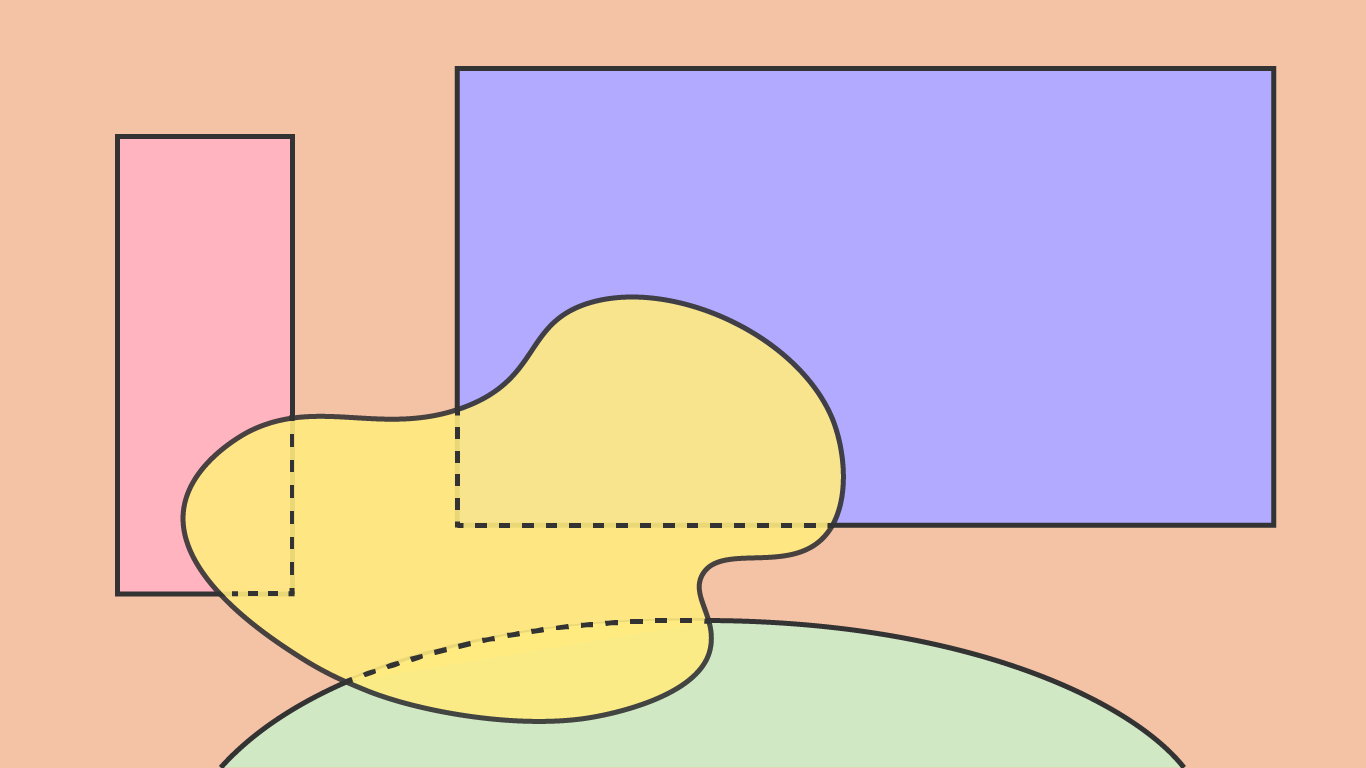Case Study
Concept
for webOS 5.0
LG Electronics,
2018
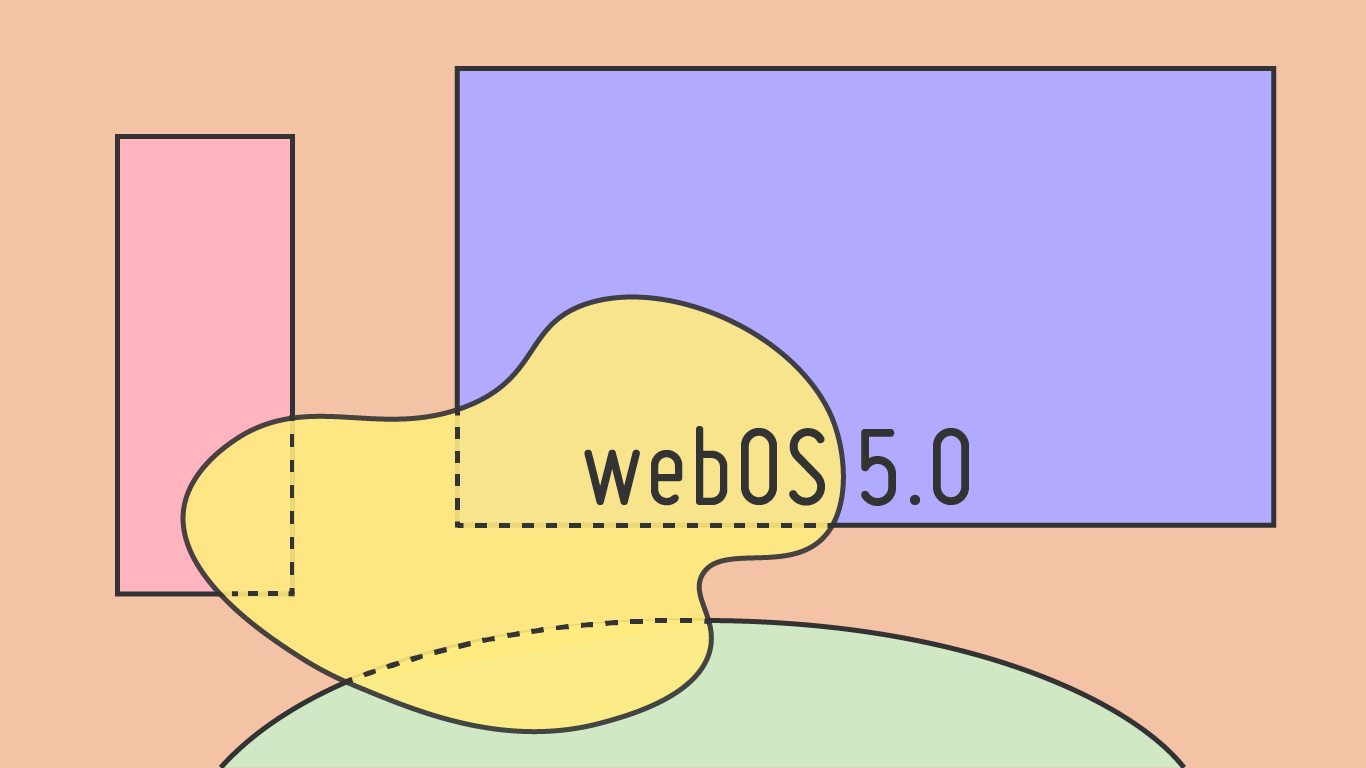
NOTE:
To comply with my confidentiality agreement I have omitted and appropriated confidential information.
These designs are a reinterpretation of the original.
This project presented the concept and direction of LG's webOS 5.0 TV launched in early 2020. Through the design process, we implemented new UIs and functions based on the value we wanted to deliver through our new “AI TV”.
DURATION
4 months
MY ROLE
Ideation, User research,
Interaction design, Prototyping
TEAM
Deagu Kim, Head of Advanced Research
Jaewook Kim, Eunji Park, Sohyun Kim,
Product Designer
METHODS
User interview, Persona, User Journey map, Empathy map, Use cases, Wireframing, Prototyping
TOOLS
AdobeXD, Axure, Power Points
PROBLEM
What is the next TV experience following Smart TV?
What kind of new experience will the users want?
PROCESS
Followed Human Centered Design process for 4 months
We investigated how users may want to have new experiences with TVs, following Human Centered Design process. Letting user research be our guide, we ideated multiple solutions; from re-designing the existing functions to creating some new services. We then developed a high-fidelity interactive prototype based on our findings.
DISCOVERY
Trend Analysis
Analyzing the recent trends and learning about users is always my first step of starting a new project. We focused on finding trend keywords and social and cultural happenings in 2018-2019 and broadly studied what thoughts people have, how they spend time, and what kinds of services and products they use the most.
Small but certain happiness for myself (小確幸)
The economic slowdown and uncertainty about the future made people anxious and insecure. Especially in South Korea, unemployment rate has increased for decades. This economic crisis let young people spend their time and money on “small but certain happiness for themselves”. They would like to enjoy meaningful experiences and buy cost efficient products, rather than just having cut back spending or wasting like "Yolo".
Alone, together
One-person households are becoming increasingly common around the world. People became familiar with being alone making "Querencia" with their own tastes to appreciate their time the best, which led self-interior and "deskterior", "Homeludens" trends.
On the other hand, humans are social creatures. People still want to be connected with others at the same time. For example, people love to watch "Meokbang" (eating show) on YouTube while having lunch by themselves, or actively interact with other people on social medias even though they physically stay alone most of the time.
Tailored personalization
People are keen to improve their work-life balance, and some governments and corporations actually encourage them to do so, which means many people these days have more free time than ever! And they are willing to spend the time as efficiently and happily as possible. Many of these people feel satisfied with the curated and personalized content on their timelines because they don't need to spend extra time searching for their favorites. Of course, the usage of personal data and privacy issues will stay as their concern, but they are at least aware that the recommendation algorithms are pretty accurate thanks to the AI technology.
Listening to the users
We conducted Focused group interviews with the topic of "TVs in the future" and have got some insights from them.
Never forget that TV is a lean-back device
"Smart TVs are too difficult to use"
"I didn't know that my TV already has that function"
"I don't understand why my remote has so many keys that I never use"
From the Analog TV to the Smart TV, the complexity of TV UI/UX has increased dramatically. TV manufacturers were competing on the number of apps they have, so they randomly jammed numerous functions into TVs. Smart TV became like a smart phone which is no more a lean-back device. People need to learn how to use remote and apps and then think Smart TVs are difficult to use and even useless.
We thought AI can reduce the complexity and helps users to use TV functions easily so that people can utilize lots of TV functions but still lean back.
The Shift in Viewing Habits
"I spend 4-5 hours straight watching Korean dramas on Netflix or IPTV"
"I use my smarphone even while watching TV"
"I am sometimes not able to stop watching YouTube because of the autoplay"
Even though many people mainly watch Live TV, many users already cut their cords and use TV as a medium to enjoy 3rd parties app like Netflix, YouTube, or IPTVs. They responded that watching VOD or netflix is better in term of time management. Some are heavy binge-watchers and most of them love explore content and get recommendations based on their preferences.
AI = voice commands
"AI? I know there are many AI speakers these days like Alexa, Google home"
"AI TV sounds like knowing about my preference very well"
"Siri? Bixby?"
Since Google AlphaGo changed the paradigm, the world has opened their eyes to AI technologies. However, people are still not knowing much about what AI is. Most of the interviewees understood only voice commands as AI technology, such as AI speakers or AI assistant. In other words, voice commands are essential if we want to make our TVs look like an AI machine.
Competitive Analysis: connectivity, IoT & VUI
Samsung has started to give marketing messages of AI TV using their AI assistant, "Bixby". However, the level of AI functons is still just launching an app with voice commands. Rather, they are focusing connectivity with smart phones and other home appliances and TV Plus service which provides abundant content to watch for free.
There are some TVs using "Voice print" in the market.
Google TV has improved based on Google assistant, but there is no special function related to Live TV.
Persona & User Journey Map
Based on the precedent research, we synthesized our findings and were able to create user journey maps and personas. These exercises formed a great foundation to move into feature ideation and prioritisation.
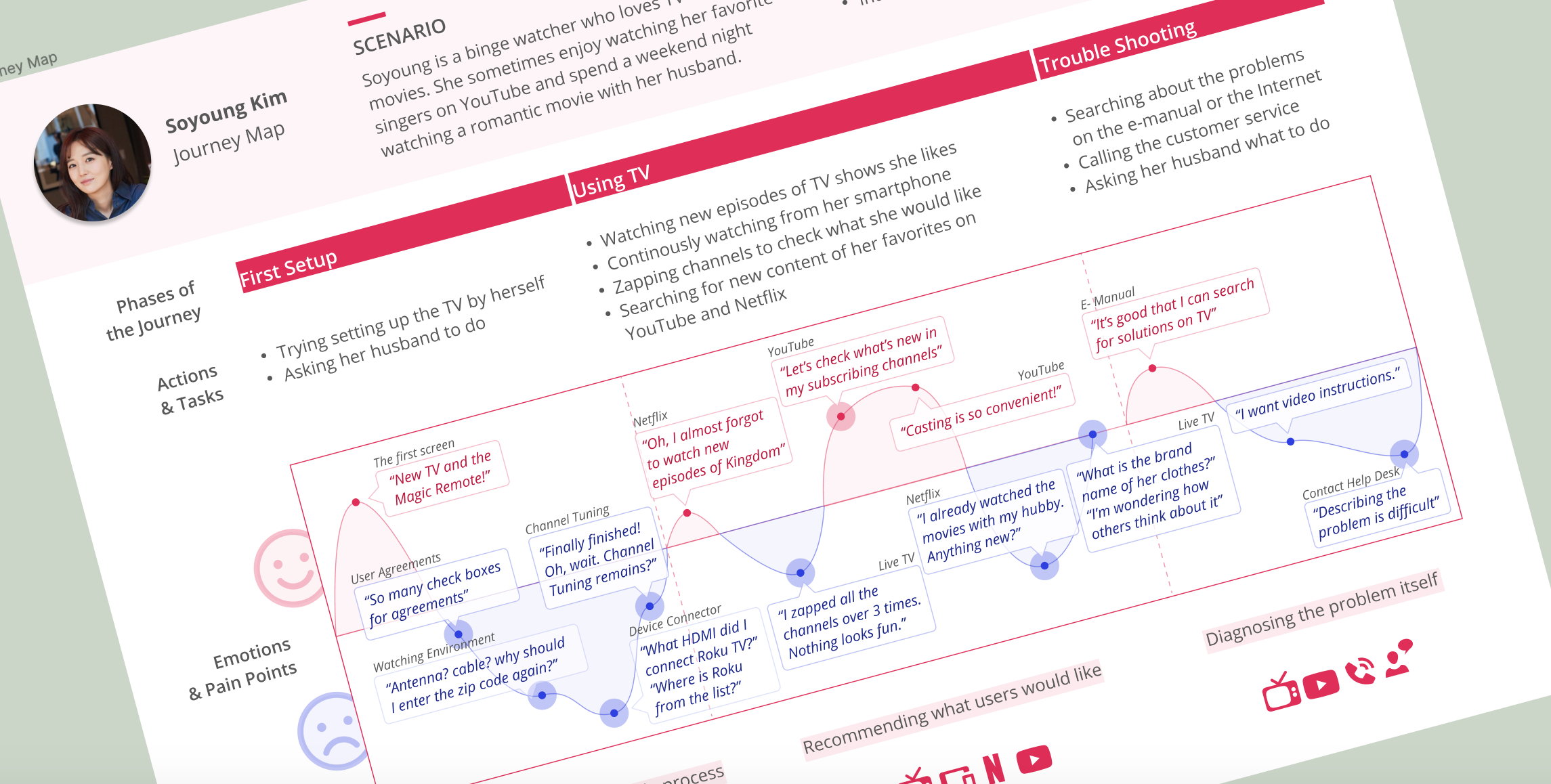
Watching TV became more personal than before.
From the Journey mapping, we could find that even though a family shares one TV in the living room, its user changes according to the time. There are more occasions that people watch TV alone than together with others.
Smart features are not visible enough.
There were not many touch points for users to experience smart features on TV from the Journey map.
The "First Use" is a critical touch point.
TV UX usually starts when users turn on the TV for the first time. They need to set up the TV themselves in most of the countires. From how it looks like to how much time they spend on it effect on user's first impression.
The moment of user picking up their smartphones while watching TV
We found some intereting moments when users grab their phones watching TV. Googling what they just saw on TV, taking pictures of TV screen and texting/sharing to friends or simply for multitasking.
IDEATE & DESIGN
We brainstormed and designed 4 concepts from the findings.
The Fisrt Look
The AI TV needs to give an "AI-like" impression to users at first sight so that users naturally recognize and expect smart features from our TVs. We've found some pain points in First Use from the Journey mapping and we checked all the stages one-by-one to simplify the whole procedure.
1. Removing Bean Birds images* and reducing the number of stages
2. Auto detection for wired cables
3. Auto-filling function for address & zip code
4. Actively exposing new features while scanning signals
*The pevious First Use was designed to give "fun" to users by bringing "Bean Birds" characters to the forefront, which are the official characters of LG webOS TV. However, the splash images that Bean Birds characters appear are only for cheering you up in the middle. So we skimmed off all the splash images first.
Put all the stages of the First Use on the wall and skimmed off the unnessary stages and checked how we could make it simple
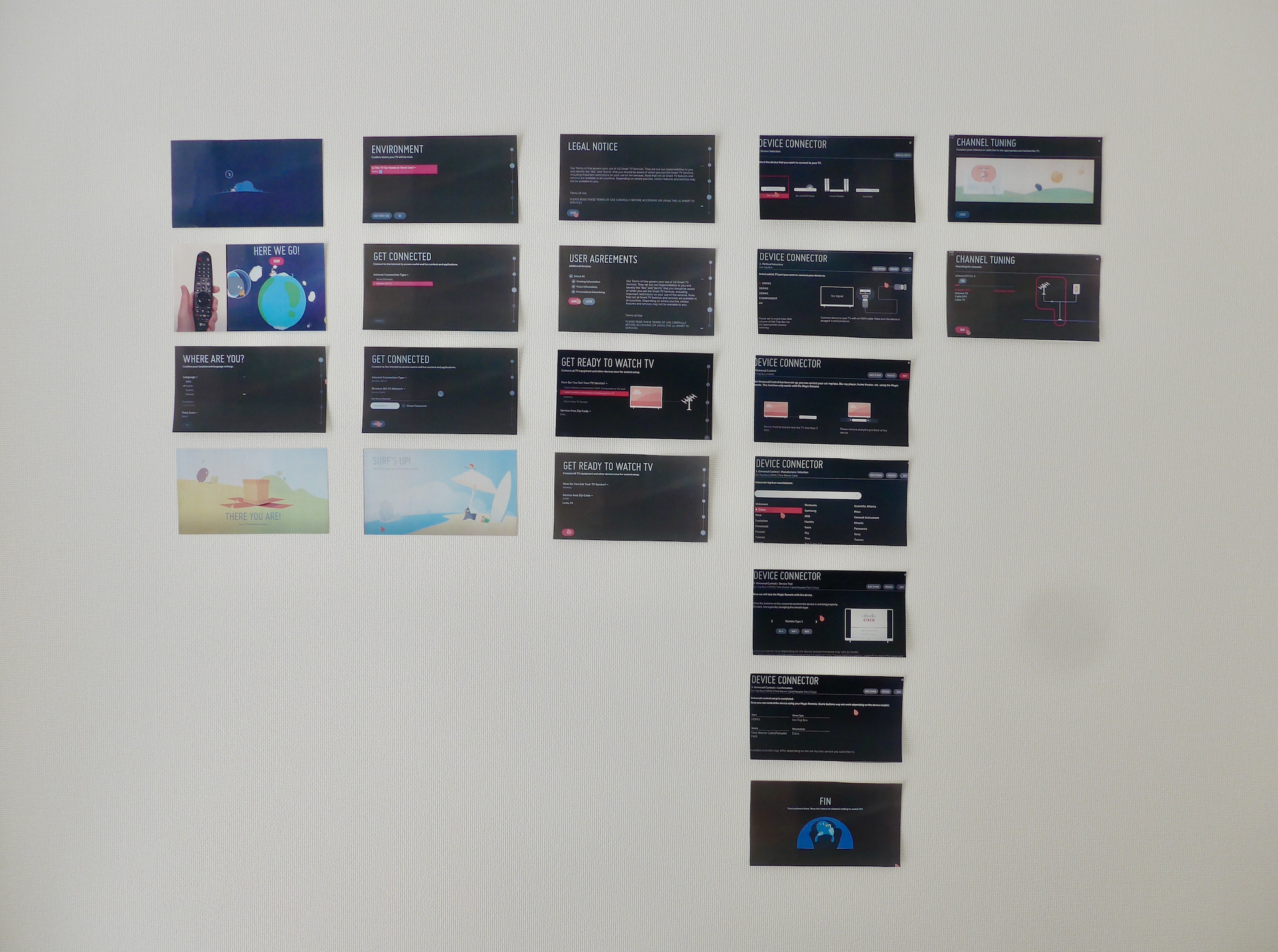
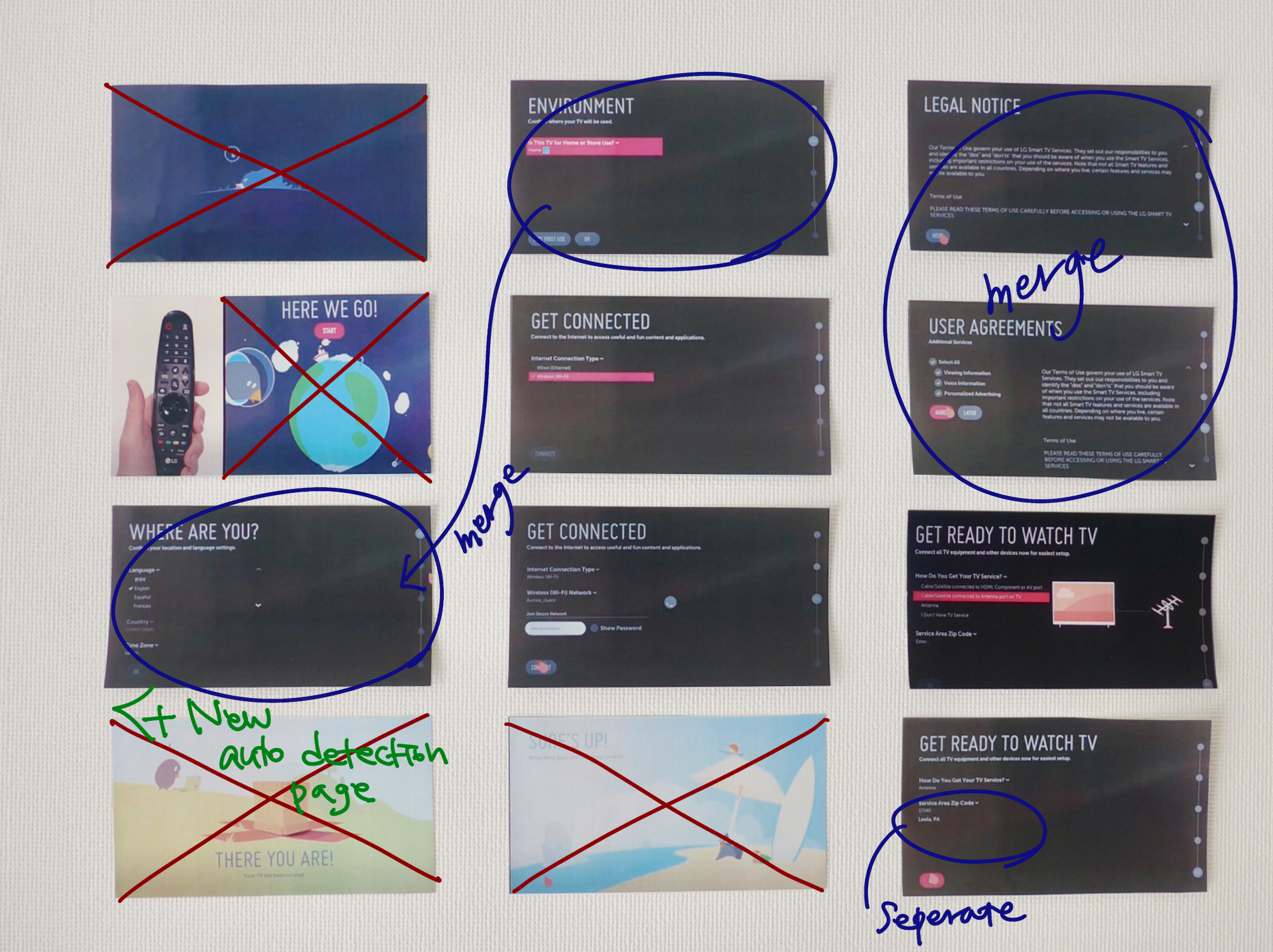
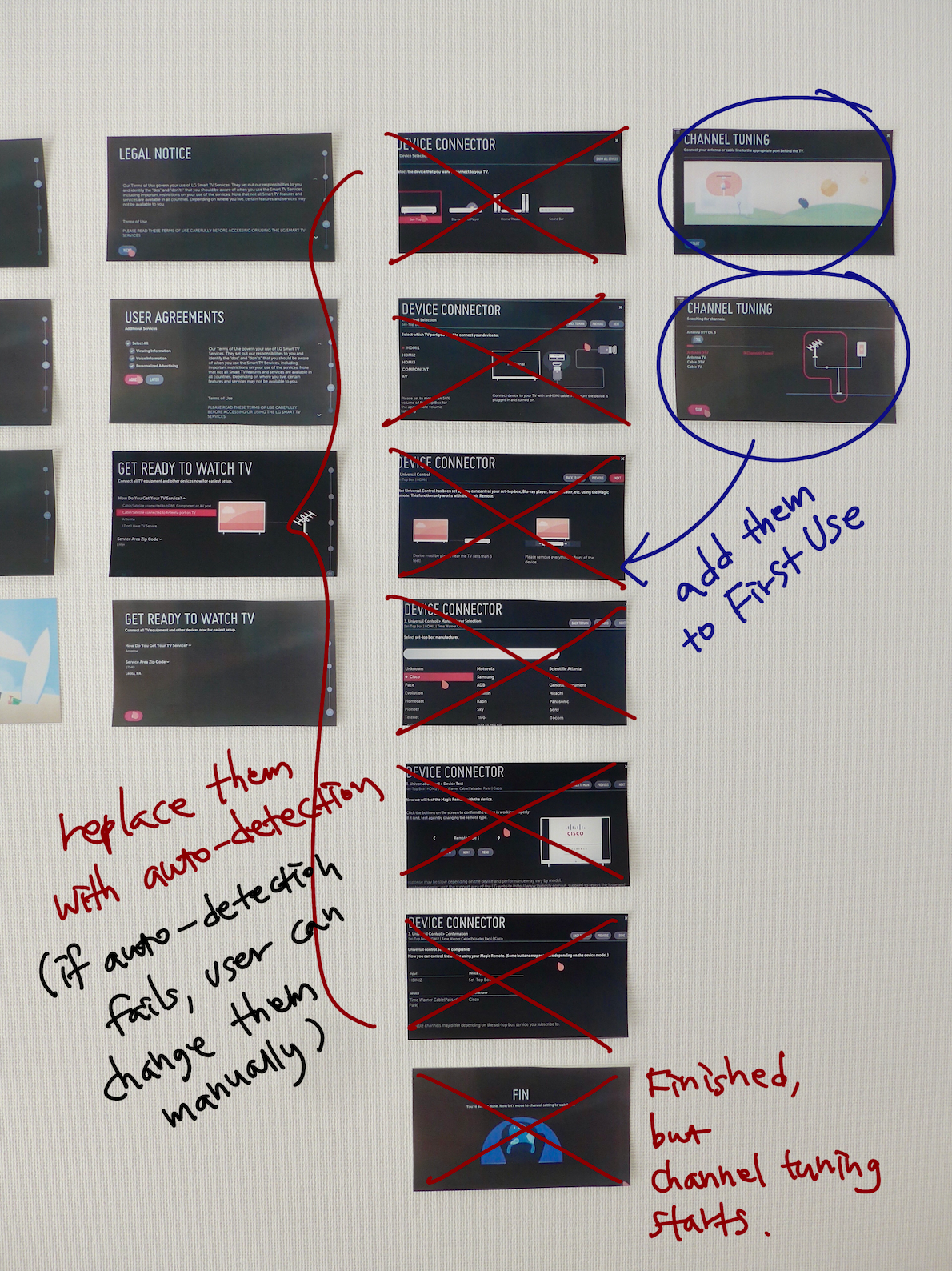
We finally developed all the ideas into wireframes to confirm the whole process and its usability.
(They were originally implemented by Power Points. The wireframes below are done by Figma by myself)
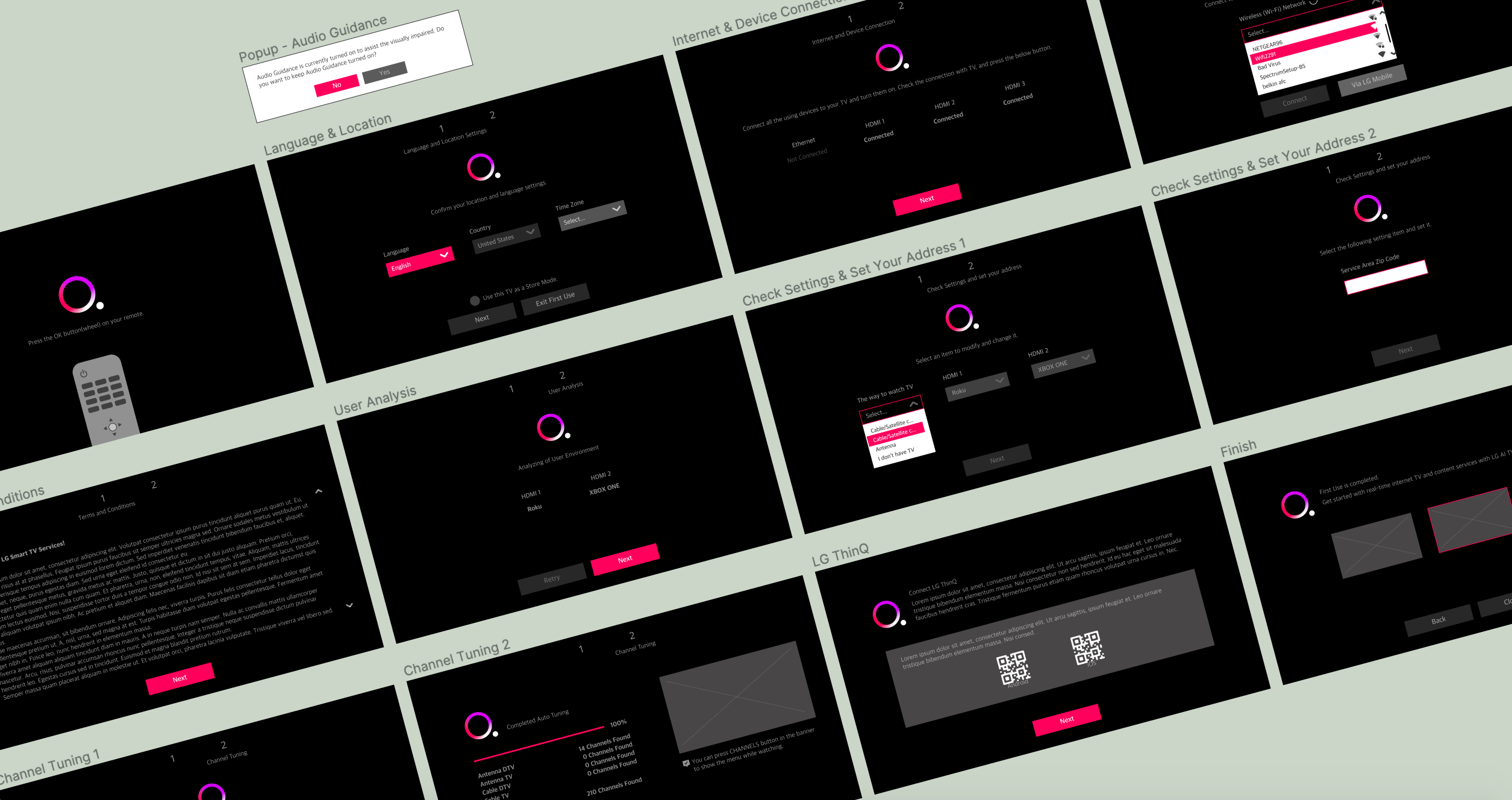


The overall look & feel has been changed and many steps were merged or eliminated in order to provide a seemless and simple experience.


Especially, we adopted BLU for dececting external inputs automatically. It reduced the process from the long and boring 7 steps into only one page.


Futhermore, there were so many unnecessary clicks for user to select by the remote controller such as in User Agreements. We also eliminated all of them after confirming all the the regulations.
The concepts below are currently being developed and still confidential.
Chameleon UI
AI-curated Channel
Feel Connected
PROTOTYPE
We presented the concepts with working prototypes to stakeholders and discussed about their feasibility.
All the concepts were developed into working prototypes by Axure and we shared them with internal product managers, engineers and graphic designers and updated the them in an interative approach.
Here I introduce the First Use reproduced using Figma by myself.
BEFORE
AFTER
OUTCOME
LG 4K Smart TVs got the highest ratings in Consumer Reports
& Inquiring about First Use has decreased by 20%
Consumer Reports announced the best 4K Smart TV in 2020 and LG webOS 5.0 was selected. The smart features including the first setup as well as the hardware features of OLEDs were spoken highly of by diverse magazines. Especially the auto-detect function for external outputs was praised and they mentioned that the whole procedure got so much simpler and intuitive.
On the other hand, according to the internal data, the number of customers inquiring about First Use has decreased by 20% thanks to the new UI of First Use. We proved that UX/UI design actually retrench expenditure.
REFLECTIONS
Some technical problems and legal issues related to the new concepts remain.
The three concepts are still in a developing stage due to some technical and broadcast regulation issues in all the countries where we sell our products. It must be a long journey to launch all the concepts according as they are novel. However, it was very meaningful work for me to make the blueprint for a new OS version of LG TVs. Even though I could not launch the rest of the concepts together with the team members, experiencing the a series of the UX planning process, from conductiong a user research to build a prototype, was a great practice as a UX designer. I learned how to deal with solving complicated issues with so many stakeholders step-by-step and enjoyed working with my colleagues.
Selected Works
